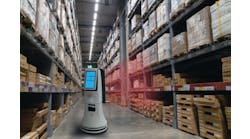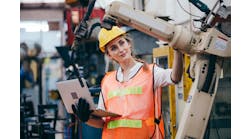The modern warehouse worker is a robot (and it's really good at its job)
Like many other aspect of modern manufacturing, robotics are changing processes on the warehouse floor, where you’re as likely to see a robot as you are a human among the aisles in a smart facility.
How is this trend altering how businesses run their warehouses? We connected with Jim Lawton, Zebra Technologies vice president and general manager of robotics automation to learn more…
Smart Industry: How are new robotic technologies changing the factory / warehouse floor?
Jim: Robots and robotic technology, including cloud-based software, advanced algorithms for analytics and advanced sensors, are the most powerful catalyst for change in how factories and warehouse operations run. From reducing the physical and mental toll of dirty, dull and dangerous work on people to increasing productivity, throughput and accuracy, robotic automation is improving operational performance through the optimization of workflows at every stage.
A key difference in today’s robotic technology is that it works best when it works in collaboration with people. I know that sounds counter to the old narrative that automation replaces people, but the truth is that in factories and warehouses there are tasks that require the unique abilities that people bring—from the finesse of the human hand to the cognitive ability to problem solve and make decisions. The combination is an effective antidote to the pervasive state of uncertainty that plagues fragile supply chains—building responsive and agile operations.
Smart Industry: What new capabilities are they enabling? Opening the door to new workforces?
Jim: The next generation of workers are looking for jobs in STEM-related fields, and robotics is one of those. Innovation in warehouse technology includes robots, but it also includes wearables and AI-driven software. The warehouses and manufacturing operations of today are much more likely to rely on the kinds of advanced technology that workers are looking for in their careers. In fact, companies that invest in innovation are likely to attract and retain workers: Zebra’s 2022 Warehousing Vision Study found that 83% of associates are more likely to work for an employer that gives them modern devices to use for tasks.
Smart Industry: What types of technologies are most common in this space?
Jim: Common technologies are the ones that have been a part of automation systems for a decade or so, e.g. sensors and cameras. Today, IoT gateways that allow software to access and orchestrate the behaviors of the multiple technologies that enable factory and warehouse workflows (think fixed conveyors, doors, elevators and other pieces of material-handling equipment) are increasingly common. We’re in the early stages of combining collaborative robotic arms with collaborative AMRs, i.e. the combination of mobile robotics and manipulation.
A little further off, but on the horizon, is the use of drones that autonomously fly through the warehouse, gathering insight and data into critical information on things like inventory levels. This application is especially useful in high-bay storage, where it is traditionally time-consuming and labor intensive to track and monitor.
Smart Industry: Aside from the primary task they accomplish, what secondary benefits do robotics offer enterprises?
Jim: Collaborative robots, like autonomous mobile robots, are much more brain than brawn. In other words, that while the robot is a piece of hardware, it’s the software on board that elevates what it is able to do.
Take warehouse and manufacturing operations, where the optimization of material movement—whether we are talking about inbound shipments that need to be put away, customer orders that need to be picked, packed and shipped, delivery or kitting of materials to be assembled or even trash and recycling—is how things get done.
Optimizing material movement involves dozens of workflows that need to be synchronized or orchestrated. And data is essential to making that happen. In the warehouse, for example, data can answer questions such as which robot is carrying which order, how many items are assigned to that robot, how many orders are assigned to that robot, what is the best route for the robot to take to fully execute the order—from pick to pack to ship. It can also inform which parts of the workflow are best handled by people and which parts are best handled by robots.
Getting those answers—and many others that need to be made in order for the operation to perform as it must—is critical to quickly and efficiently completing orders.
Smart Industry: Do factory personnel like working with these tools or is adoption reluctant?
Jim: The most successful rollouts I’ve seen are ones where the people who will be working with the robots are engaged in the earliest stages of planning the implementation. These are the people who know best what’s involved, know where the “gotchas” are and know how best the work can be done. When that happens, there’s no reluctance. People are excited to work with robots—not only because the worst part of their jobs is taken over by the robot, but also because it means they will be doing work that requires what people bring to it—creativity, critical thinking and innovation.
Smart Industry: Where are we headed with these tools? What does the factory floor look like in ten years?
Jim: The pace of innovation makes it hard to say, specifically, what is next for robots. I believe that what’s next will come from software that will manage the hardware in innovative ways, e.g., being able pick the correct item from a bin full of items.
Software will give robots a broader knowledge base from which to learn and give users greater flexibility in applications. At the same time, hardware will advance. Sensor technology, for example, will become cheaper and more capable—just like my iPhone and Oura ring, which can sense better than ever before. That trend will continue and, along with software advances, will make it possible for robots to take on tasks not commercially viable in the past.
I’m excited by these breakthroughs in large part because I believe that there’s benefit beyond operational performance. That in addition to improving how operations are run, this innovation will change what it means to work in those operations in ways we can only imagine—and maybe turn these jobs back into the “good jobs” that people actually want.



